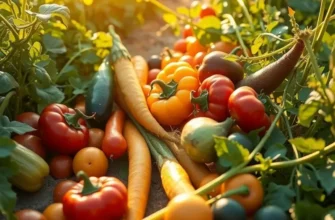Incorporating fiber-rich foods into your diet doesn’t have to be daunting. With a variety of delicious options and easy strategies, everyone can enjoy the health benefits of fiber. From fruits and vegetables to whole grains and legumes, finding ways to include these foods can be both enjoyable and straightforward. Let’s explore effortless ways to boost your dietary fiber, promote better digestion, and improve overall well-being.
Embracing Fruits and Vegetables

Elevating your fiber intake can be a delightful journey through the vibrant world of fruits and vegetables. These colorful foods are not just eye candy; they provide a rich source of dietary fiber that can seamlessly become part of your everyday routine.
To start, consider integrating fruits and vegetables into your breakfast. A smoothie is an excellent vehicle for this. Blend high-fiber options like berries, bananas, and a handful of spinach to kickstart your morning. Not only do these ingredients provide a fiber boost, but they also add a satisfying freshness to your day.
When planning your meals, think about texture and flavor. Both can benefit from the addition of fiber-rich vegetables. For lunches, toss a variety of raw or roasted vegetables into your salads. Leafy greens such as kale and arugula are fantastic bases, while adding shredded carrots, chopped bell peppers, or avocado provides extra fiber. For added convenience, sliced cucumbers and tomatoes can be stashed in your fridge for quick access, minimizing prep time during busy schedules.
Snacking provides another opportunity to sneak in more fiber. Swap out processed snacks for a bowl of baby carrots with hummus or sliced bell peppers with guacamole. These options not only provide crunch and flavor but also contribute valuable fiber content. If you’re craving something sweeter, an apple or pear is easily portable and rich in soluble fiber, known for its heart health benefits.
For dinners, consider fiber-rich options like broccoli, Brussels sprouts, or sweet potatoes as side dishes. These vegetables are versatile; they can be roasted, boiled, or used in stir-fries. Sweet potatoes, in particular, are not only loaded with fiber but also offer a sweet touch to savory dishes. They can be enjoyed as a standalone item or mashed as a delicious alternative to regular potatoes.
Certain fruits and vegetables stand out for their high fiber content. Artichokes, for instance, are champions in this category. They can be enjoyed boiled or grilled, making an excellent appetizer or salad topping. Lentils and beans, though not typical vegetables, are also incredibly high in fiber. They can be used in soups, stews, or salads to enhance nutrition without requiring much effort.
Keeping a variety of fruits and vegetables within reach makes it effortless to include them in your diet. A practical approach is to prep ingredients ahead of time, ensuring they are ready for mixing into your meals as needed. This strategy aligns with concepts in practical ingredient batching, helping you manage your meals efficiently throughout the week.
With a little planning, incorporating a wide range of fruits and vegetables into your diet becomes a simple habit rather than a daunting task. Explore these fiber-packed options and transform the way you eat, one meal at a time.
Whole Grains and Legumes Made Simple

Incorporating whole grains and legumes into your daily meals can be easier than you think. These fiber-rich foods not only enhance your nutritional profile but also add delicious flavors and textures to your diet. Let’s explore some practical strategies to make this transition seamless and enjoyable.
Start your day with a warm bowl of oatmeal, which is both satisfying and rich in soluble fiber. Opt for quick-cooking varieties, or prepare overnight oats for a no-cook breakfast that’s ready when you are. To make it more nutritious, add a tablespoon of chia seeds or a handful of berries.
Transitioning to whole grains in your meals is another simple step you can take. Use whole grain bread for your sandwiches and toast. Swap refined pasta for whole grain pasta or try alternatives such as quinoa, which cooks in about fifteen minutes and provides a complete protein source. A quinoa salad mixed with colorful vegetables, nuts, and a light lemon vinaigrette makes for a vibrant, healthy lunch option.
When planning dinners, legumes prove to be an exceptional choice. Canned varieties like lentils and chickpeas are convenient and require little preparation. Lentil soups and stews offer warmth and fullness during colder months, while chickpeas tossed into salads or roasted as snacks add a wonderful crunch.
Meal prepping can further simplify the process of incorporating these ingredients into your diet. Cook larger batches of brown rice, barley, or lentils and store them in airtight containers in the fridge. With a few basic ingredients ready, you can quickly mix-and-match ingredients for diverse meals throughout the week. For additional meal prep tips, consider the insights available here.
Cooking times can often deter people from choosing whole grains and legumes, fearing they need at least an hour to prepare. However, appliances like pressure cookers can cut cooking times significantly, allowing even slow-cooking beans to be prepared in under 30 minutes. Investing a bit of time into exploring these kitchen tools can pay off in making fiber-rich meals daily.
Ultimately, by gradually integrating whole grains and legumes into your meals through small changes, you can boost your fiber intake expertly. The key is to keep experimentation in mind and have a variety of ingredients at your disposal, ensuring meals remain exciting and enjoyable without extra fuss.
Final words
Eating a fiber-rich diet can significantly enhance your health and well-being. With simple strategies to include fruits, vegetables, whole grains, and legumes into your meals, you’ll find it easy to boost your fiber intake without feeling overwhelmed. Embrace these effortless choices, and enjoy the benefits of improved digestion, increased satiety, and a vibrant lifestyle. Remember, every small step can lead to significant changes in your diet, making healthy living accessible to everyone, especially beginners in nutrition.







